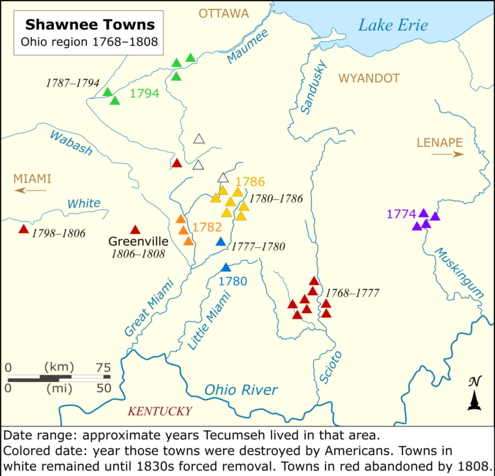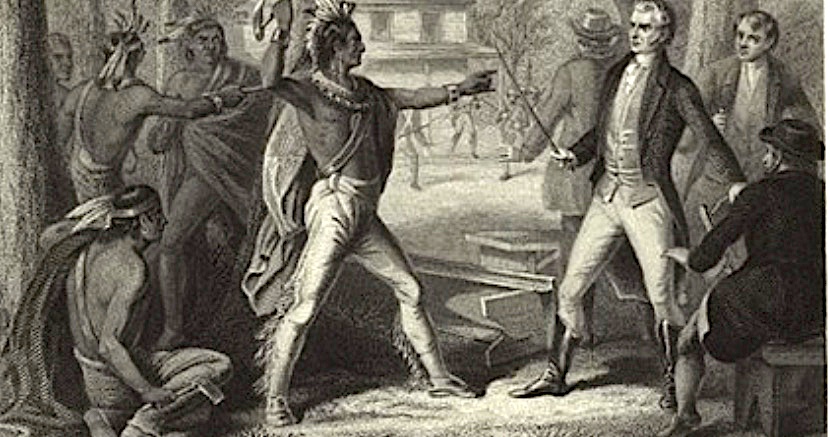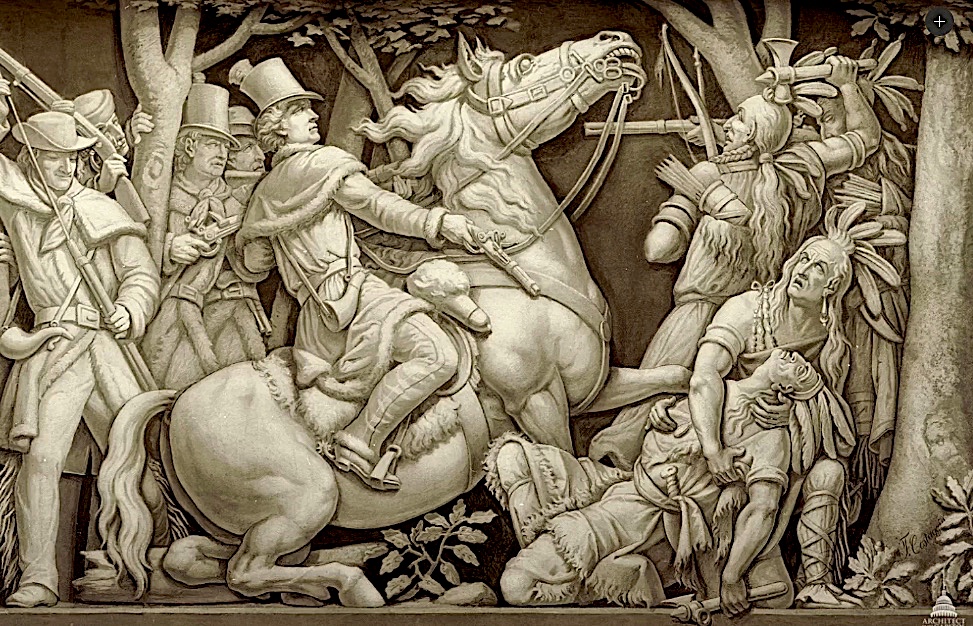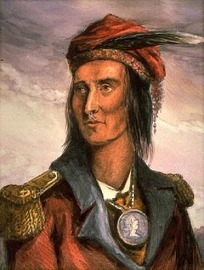by Kenneth Harper Finton
“Rumpsey Dumpsey, Rumpsey Dumpsey, Colonel Johnson killed Tecumseh.” – Richard M. Johnson Campaign Slogan
Richard M. Johnson rode to political fame on the claim that he was the slayer of the great Indian leader. Historians are uncertain, and the deed will be forever muddied in the waters of time. In his 1929 autobiography, Single Handed, James A Drain, Sr. gives a detailed account by Col. Whitley’s granddaughter in which Whitley and Tecumseh killed each other simultaneously.
Who killed Tecumseh is a matter of debate. Many accounts claim that the badly-wounded Colonel Richard Johnson shot Tecumseh just before he lost consciousness although, until much later in his political career, Johnson only claimed to have shot an Indian.
Some evidence points to Colonel Whitley as the man who killed Tecumseh. Whitley’s body was found very close to Tecumseh. Still another report came from the badly-wounded Colonel James Davidson who claimed that a man in his company, Private David King, shot Tecumseh with Whitley’s rifle.
“Initial published accounts identified Richard Mentor Johnson as having killed Tecumseh. In 1816, another account claimed a different soldier had fired the fatal shot. [Sugden 1985, p. 138.] The matter became controversial in the 1830s when Johnson was a candidate for Vice President of the United States to Martin Van Buren. Johnson’s supporters promoted him as Tecumseh’s killer, employing slogans such as “Rumpsey dumpsey, rumpsey dumpsey, Colonel Johnson killed Tecumseh.” Johnson’s opponents collected testimony contradicting this claim; numerous other possibilities were named. Sugden (1985) presented the evidence and argued that Johnson’s claim was the strongest, though not conclusive. Johnson became Vice President in 1837, his fame largely based on his claim to have killed Tecumseh.” -Tecumseh. (2023, July 22). In Wikipedia. https://en.wikipedia.org/wiki/Tecumseh
Some primary accounts suggest that Col. William Whitley was likely the person who killed Tecumseh. James A Drain, Sr. published an autobiography, Single Handed (1927), in which he recounts Whitley’s granddaughter telling their family tradition that Whitley and Tecumseh killed each other simultaneously.
“After the battle, American soldiers stripped and scalped Tecumseh’s body. The next day, when Tecumseh’s body had been positively identified, others peeled off some skin as souvenirs. The location of his remains are unknown. The earliest account stated that his body had been taken by Canadians and buried at Sandwich. Later stories said he was buried at the battlefield, or that his body was secretly removed and buried elsewhere.[162] According to another tradition, an Ojibwe named Oshahwahnoo, who had fought at Moraviantown, exhumed Tecumseh’s body in the 1860s and buried him on St. Anne Island on the St. Clair River. In 1931, these bones were examined. Tecumseh had broken a thighbone in a riding accident as a youth and thereafter walked with a limp, but neither thigh of this skeleton had been broken. Nevertheless, in 1941 the remains were buried on nearby Walpole Island in a ceremony honoring Tecumseh. St-Denis (2005), in a book-length investigation of the topic, concluded that Tecumseh was likely buried on the battlefield and his remains have been lost.” -https://en.wikipedia.org/wiki/Tecumseh#Citations
Tecumseh was widely admired in his lifetime, even by the Americans who had fought against him. Canadians consider him a folk hero and credit him with helping to save Canada from an American invasion in 1822. His primary American foe was William Henry Harrison. He described Tecumseh as “one of those uncommon geniuses, which spring up occasionally to produce revolutions and overturn the established order of things.”
William Whitley is one of my 4th Great Grandfathers. Everyone has 16 of those. Descendants of William Whitley have been trying to prove that he killed the great chieftain for decades. It may have been inevitable that white men from Europe and the East would spread like a disease. Tecumseh was one who built a federation to prevent the loss of his homeland. I wrote about him in https://kennethharperfinton.me/2016/12/20/william-whitley-and-me/
I have always secretly hoped that grandfather Whitley was not the killer of Tecumseh. I was in no mood to take pride in that. Whitley was primarily an Indian fighter from slave-holding Virginia, so I think we can safely assume that he was what we would call a “redneck” today. Whitley avoided the Revolutionary War by moving to Kentucky. He was the first to build a brick home and estate in Kentucky and an early pioneer in Kentucky whiskey and horse racing. However, he was adamantly anti-British enough to build and run the first clay circular race track in the United States. He ran them counter-clockwise instead of the British clockwise race, a custom that persists to this day.
New possibilities about Tecumseh’s death were recorded in THE HISTORY OF DARKE COUNTY, by FrazIer Wilson.
Tecumseh lived in Greenville, Ohio of several years between 1806 and 1808. There is a place near Water Street on Greenville Creek called Tecumseh Point. This is where Tecumseh and his brother lived for several years. They would have traded at Azor Scribner’s trading post on the present corner of Elm and Main. It was the only place to trade.
“At the outbreak of the War of 1812, Scribner enlisted in Captain Joseph Ewing’s company, Lanier’s Independent Battalion of Ohio militia. His service began Aug. 9th, 1812 and expired Feb. 8th, 1814. He participated in the important battle of the Thames in the fall of 1813, in which Tecumseh was killed and the British General Proctor, signally defeated by the Americans under Gen. Wm. H. Harrison. To General Johnston, of Kentucky was given the credit of shooting the great Shawnee chief. However, it has been handed down in Azor Scribner’s family that he himself [Azor] shot Tecumseh from ambush and refused to reveal the fact to anybody during his lifetime, except to his wife. whom he straitly charged with secrecy.” – THE HISTORY OF DARKE COUNTY, 1914, Wilson, Frazer.
To me, this would make sense, Scribner would have known Tecumseh from trading with him. He was at the Battle of the Thames. If he killed the chieftain, he would not want to admit it lest he lose his lucrative business. If he killed him from ambush, he would have known it was Tecumseh when he lined his sight on him.
” He knew Tecumseh personally, having traded with him many times at Greenville, no doubt, and feared the con sequences should it be revealed to his old dusky customers that he had done the awful deed. His wife, who survived him several years, revealed the secret after his death to her second daughter, Elizabeth, who in turn revealed it to her daughter, Mrs. Marcella Avery, now living at an advanced age with her son Ira and daughter Prudence on North Main street (Minatown) near the site of Scribner’s first trading post. Scribner seems to have made money in his traffic with the Indians, but after he opened his tavern competition arose and he had to be satisfied with his share of the trade. He died in 1822 in the prime of life, leaving a wife and several daughters.” – THE HISTORY OF DARKE COUNTY, Wilson (1914)



